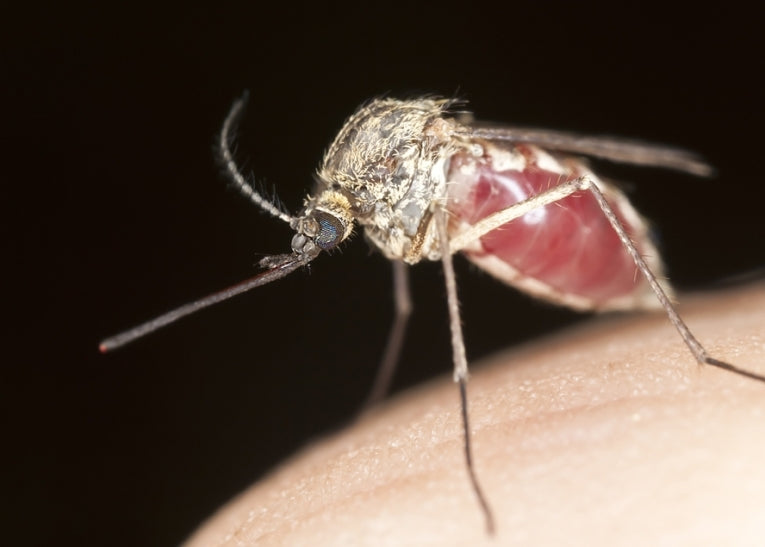Malaria is a mosquito-borne infectious disease that is caused when a female Anopheles mosquito bites an infected person and having become a carrier of the microorganism, then bites an uninfected person. The saliva from the mosquito bite introduces the microorganism into the victim's circulatory system.
The microorganism then travels to the liver, where it matures and reproduces within the red blood cells. Symptoms typically include fever and headache, which in extreme cases can progress to coma and death.
The name Malaria comes the Medieval Italian: mala aria meaning bad air. It was the name given to a disease that was also known as marsh fever because of its association with fetid swamps and marshland.
It was once endemic in most of Europe and North America. Although this is no longer the case, there are still about 10,000 cases a year in Western Europe and between 1,300 and 1,500 cases a year in the United States. Around 900 people died from the disease in Europe between 1993 and 2003.
These, however, are small numbers within the global total. The World Health Organisation (WHO) estimates that in 2010 there were 219 million cases of malaria, resulting in 660,000 deaths, but records in many areas are sketchy at best and often non-existent and a further study in 2012 indicated that the true total could be closer to 1.24 million. This is between 2,000 and 3,000 deaths every day.
65% of cases occur in children under the age of 15. Pregnant women are also particularly vulnerable, with about 125 million being at risk of infection. In sub-Saharan Africa maternal malaria is associated with an estimated 200,000 infant deaths per year.
Malaria is currently endemic in a broad band around the equator, and includes areas of the Americas, many parts of Asia and much of Africa, but it is in sub-Sahara Africa where between 85% and 90% of the fatalities occur.
A 2009 estimate reported that the countries with the highest death rate were Ivory Coast with 86.15 per 100,000 of the population; Angola with 56.93 per 100,000; and Burkina Faso with 50.66 per 100,000. A further estimate for 2010 said that the deadliest countries per population were Burkina Faso, Mozambique and Mali.
Every year 125 million international travellers visit the hundred or so countries where Malaria is endemic. Of these more than 30,000 contract the disease. In spite of an urgent need and ongoing research, no effective anti-malaria vaccine currently exists, although there are several medications that help to prevent malaria for travellers who are visiting these countries.
In order for malaria to thrive, a number of conditions are necessary. There needs to be a high human population and a high mosquito population to allow easy transfer between them. If, for instance, the number of mosquitoes can be lowered as has happened in North America, Europe and much of the Middle East, the disease will disappear.
For those who are affected, a variety of anti-malarial treatments are available, although resistance has developed to some of these drugs. The best courses of action are either to eliminate the mosquitoes or to prevent them from biting in the first place.
Mosquito nets help to keep the insects away from people and these can significantly reduce infection and transmission rates. The trouble is that they are not perfect and they must be used properly with the edges tucked in. They are often treated with insecticide in order to kill the mosquitoes before they have the chance to find their way past the net and are said to offer 70% protection compared with no net at all.
The most logical strategy is to get rid of the mosquitoes. This all sounds very simple - just get rid of the mosquitoes and you get rid of the disease. DDT was developed for just this purpose, but it was later realised that its use created more problems than it solved.
A good strategy is the removal of areas of stagnant water that provide the breeding grounds, but the problem is that significant cost factors are involved. It has been estimated that a major programme to eliminate mosquitoes in Tanzania would amount to an estimated one-fifth of the country's public health budget.
World Malaria Day was established in May 2007 by the 60th session of the World Health Assembly, which is the decision-making body of the World Health Organisation.
The day was established to provide "education and understanding of malaria" and to spread information on "year-long intensified implementation of national malaria-controlled strategies, including community-based activities for malaria prevention and treatment in endemic areas."
The tragedy is that this is a disease that is completely preventable yet it kills around two people every minute of every day. The very least that World Malaria Day can do is to raise global awareness of this international disgrace.










